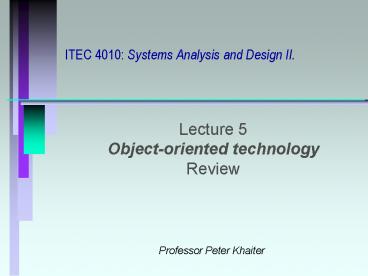ITEC 4010: Systems Analysis and Design II. PowerPoint PPT Presentation
1 / 28
Title: ITEC 4010: Systems Analysis and Design II.
1
ITEC 4010 Systems Analysis and Design II.
Lecture 5Object-oriented technology Review
Professor Peter Khaiter
2
Topics
- Fundamentals of Object Technology
- Instance object
- Class
- Association
- Aggregation and Composition
- Generalization
- Class Object
3
Fundamentals of OT
- Object has
- State
- Behavior
- Identity
- Objects and natural systems
4
Instance object
- Class
- Instance object
- Class object
5
How objects collaborate?
6
How objects identify each other?
- OID
- OID links
- Object longevity
- Persistent object
- Transient object
- Object communication via
- Persistent OIDs
- Transient OIDs
7
Persistent link implementation
Ref)(
c1 Course
course_number ITEC4010
course_name Systems Analysis and Design II
teacher identity Ref_at_
8
Persistent links in UML
c1 Course
course_number ITEC4010
course_name Systems Analysis and Design II
teacher
c2 Course
teacher
course
t1 Teacher
course
9
Transient link
- How does an object know the OID of another object
if there is no persistent link? - Search on the database
- A map object
- Creating a new object
- Pointer swizzling
10
Class
11
Attribute
12
Attribute type designating a class
13
Attribute visibility
14
Operation
15
Association
16
Association degree
- Binary
- Unary (singular)
- Ternary
17
Association multiplicity
- 0..0
- 0..1
- 0..
- 1..1
- 1..
18
Association link and extent
- Link association instance
- Extent set of association instances
Shipment 1
Shipment 1
Link 2
Link 2
Order 1
Order 1
Link 1
Link 1
with
with
3 references
3 references
Shipment 2
Shipment 2
Link 3
Link 3
Link 4
Link 5
L
ink 4
Order 2
Order 2
Shipment 2
Shipment 3
19
Association class
Parameterized type
20
Composition and aggregation
- Composition aggregation by value
- Aggregation aggregation by reference
- Properties
- Transitivity
- Asymmetry
- Existence dependency
21
Generalization
- Inheritance
- Reuse
22
Polymorphism
The same signature (operation name and the number
and type of arguments)
23
Multiple inheritance
24
Multiple classification
- Multiple inheritance
- A class may have many superclasses, but a single
class must be defined for each object
- Multiple classification
- An object is simultaneously the instance of two
or more classes
- The problem arises if Person is specialized in
few orthogonal hierarchies - Person can be Employee or Student, Male or
Female, Child or Adult, etc. - Without multiple classification
- need to define classes for each legal combination
between the orthogonal hierarchies - ChildFemaleStudent etc.
25
Dynamic classification
- An object does not only belong to multiple
classes but it can gain or lose classes over its
lifetime - A Person object can be just an employee one day
and a manager (and employee) another day - In most current object-oriented programming
environments, an object cannot change its class
after it has been instantiated (created)
26
Abstract class
- Parent class that will not have direct instance
objects - Abstract class cannot instantiate objects
because it has at least one abstract operation
27
Class object
- Object with
- Class-scope attributes and/or
- Class-scope operations
28
Summary
- Each object has a state, behavior and identity
- Class defines attributes and operations
- There are three kinds of relationships
association, aggregation, generalization - Generalization provides the basis for
polymorphism and inheritance - Multiple inheritance is likely to be supported
- Multiple and dynamic classification is still not
supported commercially - Abstract classes are important in modeling
- There are instance objects and class objects

